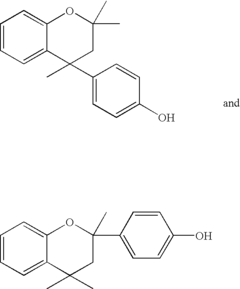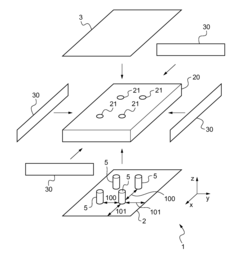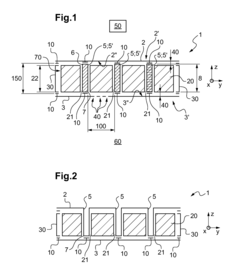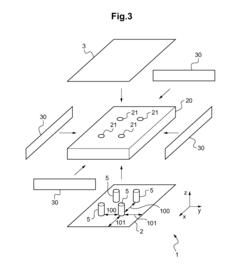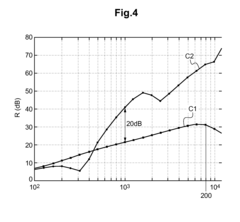How to Optimize Polycarbonate for Acoustic Applications?
JUL 1, 20259 MIN READ
Generate Your Research Report Instantly with AI Agent
Patsnap Eureka helps you evaluate technical feasibility & market potential.
Polycarbonate Acoustics Background and Objectives
Polycarbonate, a versatile thermoplastic polymer, has gained significant attention in acoustic applications due to its unique combination of properties. The evolution of polycarbonate in acoustics can be traced back to the 1960s when it was first synthesized. Initially used primarily for its optical clarity and impact resistance, researchers and engineers gradually recognized its potential in sound management.
The acoustic properties of polycarbonate have been a subject of continuous study and improvement over the past decades. Its ability to absorb and reflect sound waves, coupled with its lightweight nature and durability, has made it an attractive material for various acoustic applications. From automotive interiors to architectural elements and consumer electronics, polycarbonate has found its way into numerous products where sound control is crucial.
The primary objective in optimizing polycarbonate for acoustic applications is to enhance its sound absorption and transmission loss characteristics while maintaining its other desirable properties. This involves modifying the molecular structure, exploring different formulations, and developing innovative manufacturing techniques to tailor the material's acoustic performance.
One of the key areas of focus has been on improving the damping properties of polycarbonate. By increasing its ability to convert sound energy into heat, researchers aim to enhance its effectiveness in noise reduction. This has led to the development of various composite materials and layered structures incorporating polycarbonate, each designed to target specific frequency ranges and acoustic environments.
Another important aspect of polycarbonate optimization for acoustics is the manipulation of its surface properties. Researchers have been exploring ways to create micro- and nano-scale surface patterns that can effectively scatter or absorb sound waves. This approach not only improves the material's acoustic performance but also opens up possibilities for creating aesthetically pleasing designs with inherent sound-controlling properties.
The ongoing technological advancements in material science and manufacturing processes have significantly contributed to the evolution of polycarbonate acoustics. From traditional injection molding to advanced 3D printing techniques, new methods of fabrication have enabled the creation of complex geometries and internal structures that were previously impossible to achieve. These innovations have expanded the potential applications of polycarbonate in acoustic solutions, pushing the boundaries of what is possible in sound management.
As we look towards the future, the optimization of polycarbonate for acoustic applications continues to be driven by the growing demand for quieter, more comfortable environments across various industries. The challenge lies in balancing acoustic performance with other critical factors such as cost-effectiveness, sustainability, and ease of manufacturing. This multifaceted approach to material development ensures that polycarbonate remains at the forefront of acoustic innovation, promising exciting possibilities for the next generation of sound control solutions.
The acoustic properties of polycarbonate have been a subject of continuous study and improvement over the past decades. Its ability to absorb and reflect sound waves, coupled with its lightweight nature and durability, has made it an attractive material for various acoustic applications. From automotive interiors to architectural elements and consumer electronics, polycarbonate has found its way into numerous products where sound control is crucial.
The primary objective in optimizing polycarbonate for acoustic applications is to enhance its sound absorption and transmission loss characteristics while maintaining its other desirable properties. This involves modifying the molecular structure, exploring different formulations, and developing innovative manufacturing techniques to tailor the material's acoustic performance.
One of the key areas of focus has been on improving the damping properties of polycarbonate. By increasing its ability to convert sound energy into heat, researchers aim to enhance its effectiveness in noise reduction. This has led to the development of various composite materials and layered structures incorporating polycarbonate, each designed to target specific frequency ranges and acoustic environments.
Another important aspect of polycarbonate optimization for acoustics is the manipulation of its surface properties. Researchers have been exploring ways to create micro- and nano-scale surface patterns that can effectively scatter or absorb sound waves. This approach not only improves the material's acoustic performance but also opens up possibilities for creating aesthetically pleasing designs with inherent sound-controlling properties.
The ongoing technological advancements in material science and manufacturing processes have significantly contributed to the evolution of polycarbonate acoustics. From traditional injection molding to advanced 3D printing techniques, new methods of fabrication have enabled the creation of complex geometries and internal structures that were previously impossible to achieve. These innovations have expanded the potential applications of polycarbonate in acoustic solutions, pushing the boundaries of what is possible in sound management.
As we look towards the future, the optimization of polycarbonate for acoustic applications continues to be driven by the growing demand for quieter, more comfortable environments across various industries. The challenge lies in balancing acoustic performance with other critical factors such as cost-effectiveness, sustainability, and ease of manufacturing. This multifaceted approach to material development ensures that polycarbonate remains at the forefront of acoustic innovation, promising exciting possibilities for the next generation of sound control solutions.
Market Analysis for Acoustic Polycarbonate Applications
The market for acoustic polycarbonate applications has been experiencing significant growth in recent years, driven by increasing demand for noise reduction solutions across various industries. The global acoustic materials market, which includes polycarbonate-based products, is projected to reach a substantial value by 2025, with a compound annual growth rate (CAGR) exceeding 6% during the forecast period.
The automotive sector represents a major market for acoustic polycarbonate applications, as manufacturers seek to enhance vehicle interior comfort and reduce noise pollution. With the rise of electric vehicles, which require specialized noise reduction solutions, the demand for acoustic polycarbonate materials is expected to surge further in this segment.
The construction industry is another key driver of market growth, particularly in urban areas where noise pollution is a growing concern. Acoustic polycarbonate panels and sheets are increasingly being used in building facades, windows, and interior partitions to improve sound insulation properties.
The consumer electronics sector also presents significant opportunities for acoustic polycarbonate applications. As the demand for high-quality audio devices and smart speakers continues to rise, manufacturers are turning to advanced materials like optimized polycarbonate to enhance acoustic performance and product durability.
In the aerospace industry, there is a growing need for lightweight materials with excellent acoustic properties. Polycarbonate-based composites are being developed to meet these requirements, offering potential for market expansion in this high-value sector.
Geographically, North America and Europe currently dominate the market for acoustic polycarbonate applications, owing to stringent noise regulations and high consumer awareness. However, the Asia-Pacific region is expected to witness the fastest growth, driven by rapid industrialization, urbanization, and increasing disposable incomes in countries like China and India.
The market is characterized by intense competition among key players, including major chemical companies and specialized material manufacturers. These companies are investing heavily in research and development to create innovative acoustic polycarbonate solutions that offer superior performance and cost-effectiveness.
As environmental concerns gain prominence, there is a growing trend towards sustainable and recyclable acoustic materials. This presents both a challenge and an opportunity for polycarbonate manufacturers to develop eco-friendly formulations that meet acoustic requirements while addressing sustainability goals.
The automotive sector represents a major market for acoustic polycarbonate applications, as manufacturers seek to enhance vehicle interior comfort and reduce noise pollution. With the rise of electric vehicles, which require specialized noise reduction solutions, the demand for acoustic polycarbonate materials is expected to surge further in this segment.
The construction industry is another key driver of market growth, particularly in urban areas where noise pollution is a growing concern. Acoustic polycarbonate panels and sheets are increasingly being used in building facades, windows, and interior partitions to improve sound insulation properties.
The consumer electronics sector also presents significant opportunities for acoustic polycarbonate applications. As the demand for high-quality audio devices and smart speakers continues to rise, manufacturers are turning to advanced materials like optimized polycarbonate to enhance acoustic performance and product durability.
In the aerospace industry, there is a growing need for lightweight materials with excellent acoustic properties. Polycarbonate-based composites are being developed to meet these requirements, offering potential for market expansion in this high-value sector.
Geographically, North America and Europe currently dominate the market for acoustic polycarbonate applications, owing to stringent noise regulations and high consumer awareness. However, the Asia-Pacific region is expected to witness the fastest growth, driven by rapid industrialization, urbanization, and increasing disposable incomes in countries like China and India.
The market is characterized by intense competition among key players, including major chemical companies and specialized material manufacturers. These companies are investing heavily in research and development to create innovative acoustic polycarbonate solutions that offer superior performance and cost-effectiveness.
As environmental concerns gain prominence, there is a growing trend towards sustainable and recyclable acoustic materials. This presents both a challenge and an opportunity for polycarbonate manufacturers to develop eco-friendly formulations that meet acoustic requirements while addressing sustainability goals.
Current Challenges in Polycarbonate Acoustic Performance
Polycarbonate, a versatile thermoplastic polymer, has gained significant attention in acoustic applications due to its unique combination of properties. However, several challenges persist in optimizing its performance for acoustic purposes. One of the primary issues is the material's inherent stiffness, which can lead to unwanted resonances and vibrations in certain frequency ranges. This characteristic often results in poor sound absorption and transmission loss, particularly in the mid to high-frequency spectrum.
Another significant challenge lies in balancing the acoustic properties with other desirable characteristics of polycarbonate, such as transparency, impact resistance, and thermal stability. Modifications to improve acoustic performance may compromise these essential features, necessitating careful consideration in material design and engineering. The molecular structure of polycarbonate, while advantageous for many applications, presents limitations in terms of its ability to dissipate sound energy effectively.
The density of polycarbonate also poses challenges in acoustic applications. While its relatively low density compared to some other materials is beneficial for weight considerations, it can be a drawback in terms of sound insulation properties. This necessitates the development of composite structures or multi-layer systems to enhance acoustic performance without significantly increasing weight or thickness.
Temperature sensitivity is another factor that complicates the use of polycarbonate in acoustic applications. The material's acoustic properties can vary with temperature changes, potentially leading to inconsistent performance across different environmental conditions. This variability requires careful consideration in design and implementation, especially for applications in diverse climatic settings.
Manufacturing processes for acoustically optimized polycarbonate products present their own set of challenges. Achieving consistent acoustic properties across large sheets or complex shapes can be difficult, often requiring specialized molding techniques or post-processing treatments. The integration of acoustic features, such as micro-perforations or embedded resonators, while maintaining the structural integrity and other functional properties of the material, remains a significant technical hurdle.
Lastly, the recyclability and environmental impact of acoustically modified polycarbonate pose challenges in an increasingly sustainability-conscious market. Developing acoustic solutions that maintain the recyclability of polycarbonate without introducing harmful additives or compromising its end-of-life management is a critical area of ongoing research and development.
Another significant challenge lies in balancing the acoustic properties with other desirable characteristics of polycarbonate, such as transparency, impact resistance, and thermal stability. Modifications to improve acoustic performance may compromise these essential features, necessitating careful consideration in material design and engineering. The molecular structure of polycarbonate, while advantageous for many applications, presents limitations in terms of its ability to dissipate sound energy effectively.
The density of polycarbonate also poses challenges in acoustic applications. While its relatively low density compared to some other materials is beneficial for weight considerations, it can be a drawback in terms of sound insulation properties. This necessitates the development of composite structures or multi-layer systems to enhance acoustic performance without significantly increasing weight or thickness.
Temperature sensitivity is another factor that complicates the use of polycarbonate in acoustic applications. The material's acoustic properties can vary with temperature changes, potentially leading to inconsistent performance across different environmental conditions. This variability requires careful consideration in design and implementation, especially for applications in diverse climatic settings.
Manufacturing processes for acoustically optimized polycarbonate products present their own set of challenges. Achieving consistent acoustic properties across large sheets or complex shapes can be difficult, often requiring specialized molding techniques or post-processing treatments. The integration of acoustic features, such as micro-perforations or embedded resonators, while maintaining the structural integrity and other functional properties of the material, remains a significant technical hurdle.
Lastly, the recyclability and environmental impact of acoustically modified polycarbonate pose challenges in an increasingly sustainability-conscious market. Developing acoustic solutions that maintain the recyclability of polycarbonate without introducing harmful additives or compromising its end-of-life management is a critical area of ongoing research and development.
Existing Optimization Techniques for Acoustic Polycarbonate
01 Acoustic properties of polycarbonate composites
Polycarbonate composites can be engineered to enhance acoustic properties. By incorporating various fillers or additives, the sound absorption and transmission characteristics of polycarbonate materials can be modified. These composites can be used in applications requiring specific acoustic performance, such as noise reduction or sound insulation.- Acoustic properties of polycarbonate composites: Polycarbonate composites can be engineered to have specific acoustic properties. By incorporating various fillers or additives, the sound absorption and transmission characteristics of polycarbonate materials can be modified. These composites can be used in applications requiring noise reduction or sound insulation.
- Polycarbonate in acoustic transducer components: Polycarbonate is used in the manufacturing of acoustic transducer components due to its favorable acoustic properties. It can be utilized in speaker diaphragms, housings, or other parts of audio devices. The material's stiffness and damping characteristics contribute to improved sound quality and performance in acoustic applications.
- Acoustic measurement systems using polycarbonate: Polycarbonate materials are employed in the construction of acoustic measurement systems and devices. Their properties allow for the creation of precise and reliable instruments for measuring sound waves, vibrations, or other acoustic phenomena. These systems can be used in various fields such as automotive, aerospace, or environmental monitoring.
- Polycarbonate acoustic panels and barriers: Polycarbonate is used to create acoustic panels and barriers for noise control in various environments. These panels can be designed to absorb, reflect, or diffuse sound waves, depending on the specific requirements. The lightweight and durable nature of polycarbonate makes it suitable for both indoor and outdoor acoustic applications.
- Modification of polycarbonate for enhanced acoustic properties: Research focuses on modifying polycarbonate to enhance its acoustic properties. This can involve chemical modifications, blending with other polymers, or incorporating nanoparticles. These modifications aim to improve sound absorption, reduce resonance, or alter the material's response to specific frequencies, making it more suitable for specialized acoustic applications.
02 Polycarbonate in acoustic transducer applications
Polycarbonate materials are utilized in acoustic transducer applications due to their favorable acoustic properties. They can be used in the construction of speaker diaphragms, microphone housings, or other audio components. The material's stiffness and damping characteristics contribute to improved sound quality and performance in these devices.Expand Specific Solutions03 Acoustic measurement techniques for polycarbonate materials
Various techniques and methods are employed to measure and characterize the acoustic properties of polycarbonate materials. These may include impedance tube measurements, reverberation chamber tests, or ultrasonic testing. Such measurements help in understanding and optimizing the acoustic behavior of polycarbonate for specific applications.Expand Specific Solutions04 Polycarbonate blends for improved acoustic performance
Blending polycarbonate with other polymers or additives can lead to improved acoustic properties. These blends may offer better sound absorption, reduced resonance, or enhanced vibration damping. The specific composition of the blend can be tailored to meet the acoustic requirements of various applications, such as automotive interiors or electronic device housings.Expand Specific Solutions05 Acoustic properties of polycarbonate in structural applications
Polycarbonate's acoustic properties play a role in its use for structural applications. Its ability to absorb or reflect sound waves can be advantageous in building materials, automotive components, or aerospace structures. The material's acoustic behavior, combined with its mechanical properties, makes it suitable for applications where both structural integrity and sound management are important.Expand Specific Solutions
Key Players in Acoustic Polycarbonate Industry
The acoustic applications of polycarbonate are in a competitive and evolving market, characterized by a mix of established players and emerging innovators. The industry is in a growth phase, driven by increasing demand for noise reduction solutions in various sectors. The global market for acoustic materials is expanding, with polycarbonate gaining traction due to its versatile properties. Technologically, the field is advancing rapidly, with companies like SABIC, Covestro, and Kingfa leading in material innovations. Academic institutions such as Jilin University are contributing to research and development. Collaborations between industry leaders like Bayer and BASF with specialized acoustic companies are pushing the boundaries of polycarbonate's acoustic performance. The market is seeing a trend towards sustainable and high-performance solutions, with companies like DSM and Asahi Kasei focusing on eco-friendly alternatives.
SABIC Global Technologies BV
Technical Solution: SABIC has developed innovative polycarbonate solutions for acoustic applications, focusing on their LEXAN™ resin portfolio. Their approach involves modifying the molecular structure of polycarbonate to enhance its sound-absorbing properties while maintaining its inherent strength and durability. SABIC has introduced grades with micro-cellular structures that effectively trap sound waves, reducing transmission and echo[4]. They have also developed multi-layer polycarbonate sheets that combine different densities and compositions to optimize acoustic performance across various frequency ranges. SABIC's research has led to the creation of polycarbonate composites that incorporate sound-absorbing materials, such as glass fibers or specialized fillers, to further improve acoustic properties[5]. These advanced materials find applications in automotive interiors, building and construction, and consumer electronics sectors, where noise reduction is crucial.
Strengths: Broad portfolio of acoustic solutions, strong R&D capabilities, and global manufacturing presence. Weaknesses: Potential challenges in achieving cost-effectiveness for mass-market applications.
Covestro Deutschland AG
Technical Solution: Covestro has developed a range of polycarbonate materials optimized for acoustic applications. Their Makrolon® Sound series features specially engineered grades with enhanced sound transmission and absorption properties. These materials incorporate microscopic air pockets and specific molecular structures that help to dampen sound waves and reduce resonance[1]. Covestro's approach includes modifying the polymer chain structure and adding specific fillers to achieve desired acoustic performance. They have also implemented advanced processing techniques to create layered structures within the polycarbonate, further improving its sound-dampening capabilities[2]. The company has focused on balancing acoustic properties with other essential characteristics such as impact resistance and transparency, making their solutions suitable for various applications including automotive interiors, electronic devices, and architectural elements[3].
Strengths: Extensive experience in polycarbonate development, ability to balance acoustic properties with other material characteristics, and a wide range of tailored solutions. Weaknesses: Potential higher costs due to specialized formulations and processing techniques.
Innovative Approaches in Polycarbonate Acoustic Enhancement
Polycarbonate and molded polycarbonate articles
PatentInactiveUS6740730B1
Innovation
- Development of solvent-free, low-branching, thermoplastic aromatic polycarbonates via the transesterification process with specific chain terminators and catalysts, resulting in polycarbonates with reduced erroneous structures and improved hydrolytic stability and mechanical properties.
Soundproofing cladding panel, and an aircraft
PatentActiveUS20150144422A1
Innovation
- A self-supporting acoustic insulation panel design featuring a non-self-supporting visible wall, a non-self-supporting invisible wall, a porous core, and link elements that mechanically link but acoustically decouple the walls, optimizing weight and acoustic performance.
Environmental Impact of Acoustic Polycarbonate Materials
The environmental impact of acoustic polycarbonate materials is a critical consideration in their development and application. These materials, while offering excellent acoustic properties, also present potential environmental challenges throughout their lifecycle.
Polycarbonate production involves energy-intensive processes and the use of fossil fuel-derived raw materials. The manufacturing phase contributes significantly to greenhouse gas emissions and resource depletion. However, advancements in production techniques, such as the use of bio-based precursors and more efficient catalysts, are gradually reducing the carbon footprint of polycarbonate production.
During the use phase, acoustic polycarbonate materials demonstrate positive environmental attributes. Their durability and long lifespan reduce the need for frequent replacements, thereby conserving resources and minimizing waste generation. Additionally, their lightweight nature contributes to energy savings in transportation applications, where reduced vehicle weight translates to improved fuel efficiency.
The end-of-life management of acoustic polycarbonate materials poses both challenges and opportunities. While polycarbonate is recyclable, the presence of additives and coatings used to enhance acoustic properties can complicate the recycling process. Developing effective separation and purification techniques is crucial for improving the recyclability of these materials.
Emerging technologies in chemical recycling offer promising solutions for recovering valuable monomers from polycarbonate waste, potentially closing the loop in material circularity. However, the energy requirements and potential emissions associated with these processes must be carefully evaluated to ensure a net positive environmental impact.
The use of acoustic polycarbonate materials in buildings and vehicles can contribute to noise reduction, which has indirect environmental benefits. By mitigating noise pollution, these materials can reduce stress on local ecosystems and improve human well-being, potentially decreasing the need for energy-intensive air conditioning in urban environments.
As environmental regulations become more stringent, manufacturers are increasingly focusing on developing eco-friendly acoustic polycarbonate formulations. This includes exploring bio-based alternatives, incorporating recycled content, and designing for easier disassembly and recycling at the end of the product's life.
In conclusion, while acoustic polycarbonate materials present some environmental challenges, ongoing research and development efforts are addressing these issues. The future of these materials lies in balancing their acoustic performance with enhanced environmental sustainability, through innovations in production, use, and recycling technologies.
Polycarbonate production involves energy-intensive processes and the use of fossil fuel-derived raw materials. The manufacturing phase contributes significantly to greenhouse gas emissions and resource depletion. However, advancements in production techniques, such as the use of bio-based precursors and more efficient catalysts, are gradually reducing the carbon footprint of polycarbonate production.
During the use phase, acoustic polycarbonate materials demonstrate positive environmental attributes. Their durability and long lifespan reduce the need for frequent replacements, thereby conserving resources and minimizing waste generation. Additionally, their lightweight nature contributes to energy savings in transportation applications, where reduced vehicle weight translates to improved fuel efficiency.
The end-of-life management of acoustic polycarbonate materials poses both challenges and opportunities. While polycarbonate is recyclable, the presence of additives and coatings used to enhance acoustic properties can complicate the recycling process. Developing effective separation and purification techniques is crucial for improving the recyclability of these materials.
Emerging technologies in chemical recycling offer promising solutions for recovering valuable monomers from polycarbonate waste, potentially closing the loop in material circularity. However, the energy requirements and potential emissions associated with these processes must be carefully evaluated to ensure a net positive environmental impact.
The use of acoustic polycarbonate materials in buildings and vehicles can contribute to noise reduction, which has indirect environmental benefits. By mitigating noise pollution, these materials can reduce stress on local ecosystems and improve human well-being, potentially decreasing the need for energy-intensive air conditioning in urban environments.
As environmental regulations become more stringent, manufacturers are increasingly focusing on developing eco-friendly acoustic polycarbonate formulations. This includes exploring bio-based alternatives, incorporating recycled content, and designing for easier disassembly and recycling at the end of the product's life.
In conclusion, while acoustic polycarbonate materials present some environmental challenges, ongoing research and development efforts are addressing these issues. The future of these materials lies in balancing their acoustic performance with enhanced environmental sustainability, through innovations in production, use, and recycling technologies.
Standardization and Testing Methods for Acoustic Polycarbonate
Standardization and testing methods play a crucial role in optimizing polycarbonate for acoustic applications. These methods ensure consistency, reliability, and comparability of acoustic properties across different manufacturers and applications. The development of standardized testing procedures has been instrumental in advancing the use of polycarbonate in acoustic environments.
One of the primary standardization efforts focuses on measuring sound transmission loss through polycarbonate panels. The ASTM E90 standard, widely adopted in the industry, provides a laboratory method for determining the sound transmission loss of building partitions. This method involves mounting a test specimen between two reverberation rooms and measuring the difference in sound pressure levels between the rooms. For polycarbonate applications, this test helps quantify the material's effectiveness in blocking sound transmission.
Another critical aspect of acoustic polycarbonate testing is the measurement of sound absorption coefficients. The ASTM C423 standard outlines the procedure for determining sound absorption of materials using a reverberation room method. This test is particularly relevant for polycarbonate products designed to absorb sound in acoustic environments. The results of this test, typically presented as absorption coefficients across different frequencies, guide manufacturers in optimizing their polycarbonate formulations for specific acoustic requirements.
Impact sound transmission testing is also essential for polycarbonate used in flooring or ceiling applications. The ISO 717-2 standard provides a method for rating the impact sound insulation of floor systems. This test involves using a standardized tapping machine to generate impact sounds on the floor surface and measuring the resulting sound pressure levels in the room below. The results help in assessing the effectiveness of polycarbonate-based flooring systems in reducing impact noise transmission.
To evaluate the long-term acoustic performance of polycarbonate, accelerated aging tests are often employed. These tests simulate environmental conditions such as temperature fluctuations, humidity, and UV exposure to assess how the acoustic properties of polycarbonate change over time. While not specifically standardized for acoustic applications, methods like ASTM D1435 for outdoor weathering of plastics can be adapted to include acoustic property measurements before and after aging.
The development of specialized testing equipment has been crucial in standardizing acoustic measurements for polycarbonate. Impedance tubes, for instance, allow for rapid and accurate measurement of sound absorption coefficients and transmission loss for small samples. This method, standardized under ISO 10534-2, is particularly useful for material development and quality control in polycarbonate production.
As the use of polycarbonate in acoustic applications continues to grow, there is an ongoing effort to refine and expand standardization and testing methods. Industry collaborations and research initiatives are focusing on developing new standards that address the unique challenges of polycarbonate acoustics, such as its viscoelastic behavior and temperature-dependent properties. These efforts aim to provide more comprehensive and accurate assessments of polycarbonate's acoustic performance, ultimately leading to better-optimized products for various acoustic applications.
One of the primary standardization efforts focuses on measuring sound transmission loss through polycarbonate panels. The ASTM E90 standard, widely adopted in the industry, provides a laboratory method for determining the sound transmission loss of building partitions. This method involves mounting a test specimen between two reverberation rooms and measuring the difference in sound pressure levels between the rooms. For polycarbonate applications, this test helps quantify the material's effectiveness in blocking sound transmission.
Another critical aspect of acoustic polycarbonate testing is the measurement of sound absorption coefficients. The ASTM C423 standard outlines the procedure for determining sound absorption of materials using a reverberation room method. This test is particularly relevant for polycarbonate products designed to absorb sound in acoustic environments. The results of this test, typically presented as absorption coefficients across different frequencies, guide manufacturers in optimizing their polycarbonate formulations for specific acoustic requirements.
Impact sound transmission testing is also essential for polycarbonate used in flooring or ceiling applications. The ISO 717-2 standard provides a method for rating the impact sound insulation of floor systems. This test involves using a standardized tapping machine to generate impact sounds on the floor surface and measuring the resulting sound pressure levels in the room below. The results help in assessing the effectiveness of polycarbonate-based flooring systems in reducing impact noise transmission.
To evaluate the long-term acoustic performance of polycarbonate, accelerated aging tests are often employed. These tests simulate environmental conditions such as temperature fluctuations, humidity, and UV exposure to assess how the acoustic properties of polycarbonate change over time. While not specifically standardized for acoustic applications, methods like ASTM D1435 for outdoor weathering of plastics can be adapted to include acoustic property measurements before and after aging.
The development of specialized testing equipment has been crucial in standardizing acoustic measurements for polycarbonate. Impedance tubes, for instance, allow for rapid and accurate measurement of sound absorption coefficients and transmission loss for small samples. This method, standardized under ISO 10534-2, is particularly useful for material development and quality control in polycarbonate production.
As the use of polycarbonate in acoustic applications continues to grow, there is an ongoing effort to refine and expand standardization and testing methods. Industry collaborations and research initiatives are focusing on developing new standards that address the unique challenges of polycarbonate acoustics, such as its viscoelastic behavior and temperature-dependent properties. These efforts aim to provide more comprehensive and accurate assessments of polycarbonate's acoustic performance, ultimately leading to better-optimized products for various acoustic applications.
Unlock deeper insights with Patsnap Eureka Quick Research — get a full tech report to explore trends and direct your research. Try now!
Generate Your Research Report Instantly with AI Agent
Supercharge your innovation with Patsnap Eureka AI Agent Platform!



